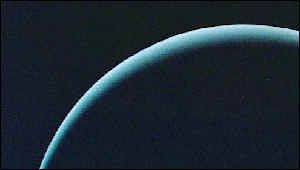 NASA Voyager 2 Image of the planet Uranus |
|||
| Faraway Mystery Planet Uranus | |||
| Planet | Moons | Voyager | Resources |
 NASA Voyager 2 Image of the planet Uranus |
|||
| Faraway Mystery Planet Uranus | |||
| Planet | Moons | Voyager | Resources |
Voyager Swings By Uranus
THE COMPLETE VOYAGER STORY
The interplanetary probe Voyager 2 flew within 50,600 miles of Uranus' cloud tops on January 24, 1986.
Before the planet Uranus was visited by the spacecraft Voyager 2 on January 24, 1986, astronomers knew of only five moons. Voyager 2 discovered ten small moons. Today, we know Uranus has at least 21 moons and astronomers suggest there may be more tiny satellites among the planet's rings.
Voyager rings. While looking at the rings around Uranus, the Voyager spacecraft uncovered strange incomplete-circle partial formations now called ring arcs. The many rings and arcs varied in depth and density.
After passing Uranus, Voyager 2 sailed on toward a rendezvous within 3,000 miles of the planet Neptune in August 1989.
Voyager found nine rings around Uranus, but they were quite different from Jupiter and Saturn rings. Uranus' rings may be young remnants of a shattered moon.
Lightning On Uranus. French scientists listening to radio signals recorded in 1986 at Uranus by the U.S. Voyager 2 spacecraft heard lightning bolts.
Uranus moons Umbriel (left) and Ariel (right) in NASA Voyager 2 photos in 1986 (click to enlarge)
The same kind of static crashes heard in an AM radio during an electrical storm on Earth were found among data transmitted back to Earth from Uranus.
Apparently the lightning strikes on Uranus are more powerful than those on Earth, but nowhere near as strong as the magnificent electrical discharges on Saturn. The bolts are giant sparks of static electricity generated by turbulence in the Uranian atmosphere.
Radio Waves. When electricity flows, it generates electromagnetic radiation. We call such energy a radio wave. A radio wave can be controlled by man using a transmitter to generate a signal. The signal can be modulated with sounds or made to carry other forms of information. On the other hand, when electromagnetic energy is not controlled, we call it noise or static. Lightning is merely a very large, uncontrolled burst of static.
The Voyager spacecraft's receiver heard strong static as it sailed past Uranus. The chaotic signals received had the same characteristics as lightning noise.
Voyager 2 Found Moons. When Voyager 2 flew within 50,600 miles of Uranus' cloud tops on January 24, 1986, it discovered a magnetic field and much ultraviolet light, known as dayglow.
Voyager 2 found 10 previously-unknown moons, the largest only 90 miles in diameter, bringing the total to 15. Astronomers previously had seen five large ice-and-rock moons. The innermost, Miranda, was found by Voyager to be one of the strangest bodies in the Solar System, with fault canyons up to 12 miles deep, terraced layers and mixed young and old surfaces.
Titania was marked by huge faults and deep canyons. Ariel had the brightest and youngest surface of Uranian moons, with many deep valleys and broad ice flows. Dark-surfaced Umbriel and Oberon looked older.
The moons Umbriel and Ariel each are about 75O miles in diameter. In NASA's 1986 pictures at right, Voyager 2 was about 346,000 miles from Umbriel. The Ariel picture is a mosaic of four images collected when Voyager 2 was about 8O,OOO miles from the moon
Shakespeare. Nine of the new moons were named for Shakespearean characters: Bianca, Cordelia, Cressida, Desdemona, Juliet, Ophelia, Portia, Puck and Rosalind. The tenth was named for Belinda whose lock of hair was stolen in The Rape of the Lock.
Voyager discovered the moons shortly before the January 28, 1986, shuttle Challenger disaster. Two U.S. congressmen had proposed naming the 10 moons for dead Challenger and Apollo 1 crew members. They prompted thousands of children, citizens and officials to write letters and sign petitions favoring naming moons for astronauts.
The IAU did name craters on Earth's Moon for the seven crew members -- Francis Scobee, Michael J. Smith, Judith Resnik, Ronald McNair, Ellison Onizuka, Gregory Jarvis and teacher-astronaut Sharon Christa McAuliffe -- killed in the 1986 shuttle Challenger launch explosion.
NASA image of the planet Uranus
Also, seven asteroids were named in 1986 by the IAU for the Challenger astronauts, two months after the shuttle exploded.
Moons discovered in the 1990s. In 1999, Erich Karkoschka of the University of Arizona spotted an 18th Uranian satellite in a Voyager 2 photograph snapped in 1986.
Click to enlarge NASA Voyager 2 image of the planet Uranus
In 1999, Kavelaars and a team of astronomers discovered the 19th and 20th moonlets orbiting Uranus. Designated 1999 U1 and 1999 U2, they are dark rocks less than 12 miles in diameter.
New moonlet (in white circle) orbiting Uranus (bottom left)
Source: International Astronomical Union
Ring gaps. Ring gaps in some Voyager 2 photos, combined with a mysterious wave in one ring, may indicate two of the unseen moons could be 11 miles in diameter. They could be orbiting at 28,200 and 28,800 miles from the center of the planet.
Hubble Space Telescope image of Uranus ring
More about the Solar System . . . Star: The Sun Inner Planets: Mercury Venus Earth Mars Outer Planets: Jupiter Saturn Uranus Neptune Pluto Other Bodies: Moons Asteroids Comets Quaoar Beyond: Pioneers Voyagers
Solar System Rockets Satellites Shuttles Stations Astronauts Deep Space History Global Links Exploring the Solar System
Uranus main page Top of this page Search STO About STO STO cover Questions Feedback Copyright 2006 Space Today Online